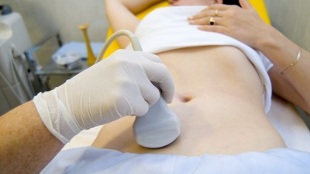
This disease is poorly understood, although several thousand observations with diagnosis and subsequent treatment have been described.
The diversity and non-specificity of the clinical picture of varicose veins in the small pelvis leads to serious errors on the part of the diagnosis, which in the future will affect the consequences.
Characteristics of varicose veins in the small pelvis
Pelvic veins are several times longer than arteries, leading to their greater capacity. This is due to the phylogeny of the vascular system in the pelvic area. The pelvic arteries are highly adaptable and potentially prone to remodeling, contributing to the formation of a closely intertwined network.
The speed and direction of blood flow are regulated by valves controlled by complex humoral mechanisms. The valves balance the pressure in different parts of the venous network.
When the valves cease to function, blood stagnation develops, this leads to vascular pathology and the formation of varicose veins. The uniqueness of the pelvic veins lies in the fact that the wide ligaments of the uterus, which hold the vessel in the hole, can narrow it and cause pathology.
Causes of occurrence
Pathological venous dilation of the pelvis can be due to the following causes:
- Disruption of the blood flow channel
- Obliteration of the venous trunk;
- Compression of safety strains at an altered position in the uterus, for example in flexion;
- ovarian failure (congenital or acquired)
- Obstructive post-phlebitic syndrome;
- Connective Tissue Pathology;
- Arteriovenous angiodysplasia;
- Long-term sitting, hard physical work
- Varicose veins of the lower extremities
- Pregnancy (3 or more) and childbirth (2 or more)
- Sexually transmitted diseases in women (chronic salpingo-oophoritis, ovarian tumors, uterine fibroids and genital endometriosis);
- Adhesion of the pelvic organs
- Obesity.
Classification by disease degree
According to the size of the dilated vein, the following degrees are distinguished:
- up to 0, 5 cm, "corkscrew" course of ships;
- 0. 6-1 cm;
- more than 1 cm.
Variants of the course of the disease
- varicose veins in the perineum and vagina in the vagina
- syndrome with venous congestion in the small pelvis;
Symptoms
- The most common - frequent abdominal pain, perineum after long static and dynamic overload. The pain intensifies in the second phase of the cycle after hypothermia, fatigue, stress, exacerbation of various diseases.
- Feeling of "out of place", pain during and after sex.
- Dysmenorrhea - menstrual irregularities, including pain.
- Secretion, more than usual, of the genitals.
- Blood stagnation leads to infertility, miscarriage, abortion.
- Violation of urination due to the expansion of the veins of the bladder.
Diagnostics
The diagnosis of the disease only by complaints is successful only in 10% of cases.
Palpation of the inner walls of the pelvis makes it possible to feel the elongated seals and venous nodules. When seen in the mirrors, cyanosis of vaginal mucosa is visible.

The chosen procedure is an ultrasound examination with color Doppler mapping, which makes it possible to detect not only varicose veins in the ovaries, but also venous thrombosis, post-thrombophlebitic occlusions. Ultrasound shows tortuosity, "worm-like", structures without signal reflection, located on the lateral surface of the uterus.
The Doppler effect is based on the blue and red hues of venous and arterial blood flow, respectively.
The ultrasound examination device using a special program detects the movement of blood from the sensor and calculates the blood flow rate and the type of vessel in the other direction.
But the exact definition of a vein or artery remains with the doctor. The Doppler method works in almost all cases, exceptions to the rules are dictated by our body, as the blood flowing from the heart is not always arterial and vice versa.
Thus, the ultrasound diagnostic physician sees this arterial or venous vessel, its size, blood flow in it, and many indicators that are not necessary by an ordinary person but play an important role in making a diagnosis. Transabdominal and transvaginal sensors are used for this.
In 5, 7% of cases, the disease is recognized randomly during screening. Normally, the venous ovarian diameter is 0. 4 cm.
CT and MRI are very accurate. With these methods, it is possible to detect accumulations of varicose veins in the uterine ligaments, ovaries and around these organs. It is possible to determine simultaneous pathology.
A very reliable method is phlebographic research.
Contrast is performed at the height of the Valsalva test against blood flow. This allows you to see accurate valve failure.
Left rectal genoroscopy, renal phlebography, superselective phleboovarioscopy and phleboovaryography on both sides are also used. These methods make it possible to determine hemodynamic and anatomical changes in renal veins and the sites where the gonadal veins flow into them.
Superselective phleboovarioscopy is performed by catheterization of gonadal veins through the contralateral femoral or subclavian vein followed by contrast injection.
Most of the blood from uvine plexus varicose veins is dumped through the ovaries. However, in relation to hypertension, it occurs through the extraorganic uterine veins into the internal iliac vein. Plexus in the veins through which outflow may occur includes sacral plexus and bladder.
In left-sided phleboovaricography, there are 3 stages of venous stasis in the uviform plexus of the left ovary:
- There is no outflow from the plexus in the left ovary, or it follows a further short path.
- There's an extra long path.
- Two additional outflow paths are visible, or one additional and additional.
At stages 2 and 3, varicose veins form in the uviform plexus of the right ovary.
Laparoscopy is used for differential diagnosis. Pathologically curved veins are located in the ovaries in the direction of the round and wide ligaments. They resemble large cyanotic conglomerates with a thin and tense wall.
The complexity of the diagnosis lies in the fact that the disease is often hidden behind signs of an inflammatory process, differs in clinical manifestations, disguises as endometriosis, prolapse of internal organs, postoperative neuropathies and many foreign diseases.
Treatment
The main purpose of treatment is to remove reflux in the veins. In the initial stages of the disease, conservative treatment is used. In the later stages of the disease, surgery is the treatment of choice.
Conservative treatment

It consists in the normalization of venous tone, improvement of hemodynamics and trophic processes.
Symptomatic treatment of individual symptoms. Non-steroidal anti-inflammatory for pain, for bleeding - hemostatic treatment.
The most important drugs in conservative treatment are venotonic drugs and platelet therapies.
Flebotonics - improves the tone of the vessel wall and increases blood flow. With this disease, it is better to consult a gynecologist about certain drugs.
Physiotherapy is an important method.
Surgical treatment
- Resection of varicose veins.
- Gonado Cavalry Shift.
- Sclerosis during laparoscopy.
- Ocular occlusion using X-ray endovascular methods.
Folk medicine
As the main factor in the onset of the disease is the weakness of the valve apparatus, all folk remedies used for varicose veins in the lower extremities are also used for this pathology.
The most commonly used are: common hazel, hops, nettles, horse chestnut, dandelion root, kombucha, willow, oak, St. John's wort, string, pollen and many more plants.
The following are effective: treatment with baths with oak, chestnut, willow, chamomile, pharmacy, herbs of cayenne, St. John's wort, string.
Prevention
- The first thing to do if you have complaints, predictors or diseases listed above is to contact your gynecologist.
- It is necessary to normalize the work regime and rest, so do not try to stay in a vertical position for a long time, physical overload.
- Do exercises to prevent "pedal", "stand-birch", "scissor legs"
- Stick to a diet: eat foods high in vitamins E, P, C, try to eat only white meat, less fatty meat, replace it with fruits, vegetables, grains.
- Drink plenty of fluids, but not less than 1, 5 liters a day.
- Get rid of obesity, bad habits.
- Contact your doctor about wearing compression clothing, it will improve the outflow of blood from the lower extremities and thereby reduce pelvic congestion.
- Avoid baths, saunas, steam rooms, hot tubs.
In order not to get sick with such a difficult to diagnose disease, you need to follow the preventive recommendations listed above. Treat your health as the most precious thing in life.
For the slightest suspicious symptoms that you can not get rid of in a few days, consult your doctor. He must provide you with highly qualified help and save you from suffering.






































